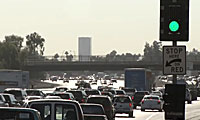Getting the green light: Valley ramp meters now more efficient
Getting the green light: Valley ramp meters now more efficient

If you drive Valley freeways during rush hour, you’re probably pretty familiar with ramp meters …
They’re the two-light signals positioned at most Valley on-ramps that tell motorists when it’s okay to head onto the freeway.
Ramp meters have been used in the Phoenix-Metro area for about the past 20 years and maybe you think not much about them has changed … but, actually they’ve recently become much more efficient!
Thanks to a project funded through the Maricopa Association of Governments (MAG), roughly 300 ramp meters have been replaced with units that use newer, smarter technology.
As ADOT’s Intelligent Transportation System Supervisor Chuck McClatchey explains in the video above, the older ramp meters were not nearly as efficient as the new models.
“The new controllers actually operate totally independent of each other, which, means you can have 15 cars in one lane, no cars in the other lane and it will give 15 straight greens and just maintain red on the left side,” he said. “The older technology would give two greens and then a green to the non-existent cars. … So you can see that it really was not that efficient.”
But how does the ramp meter “know” a car is ready and waiting to take off onto the freeway?
Well, there are actually sensors in the ground adjacent to the signals that can detect a car as it pulls up. The ramp meter will then give a green light and start metering back and forth between the two lanes.
The meters also get information from the mainline, or freeway.
If the mainline is free-flowing, then the ramp meter will put on as many cars as possible. But if the mainline traffic slows down, the sensors pick that up and the rate at which cars are given a green light slows down some to help relieve the congestion.
The system has something called a queue-loop located at the very top of the ramp, too. The queue-loop is kind of a manual override that senses when traffic is backed up on the ramp completely up to the top. If that happens, the loop is activated and the metering goes to the fastest rate until the ramp is cleared. Basically, it’s a safety factor that keeps traffic from backing up into the surface street intersections.
All these features add up and help make it a little easier for motorists to get where they need to go!
